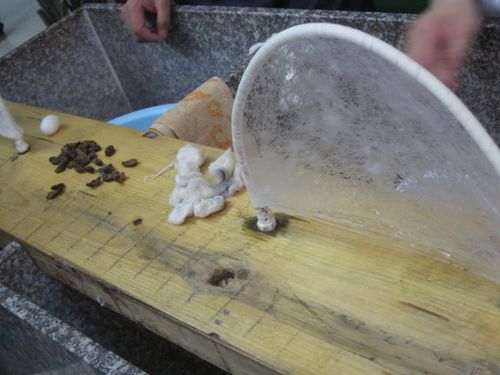About SILK
Silk fabrics is cruel fabrics it take out lives of lives of millions worm !!

Silk Production Causes Painful Death for Insects
The so-called “silkworm” is actually a domesticated insect who, in nature, goes through the same stages of metamorphosis—egg, larva, pupae, and adult—that all moths do.(6) Silk is derived from the cocoons of larvae, so most of the insects raised by the industry don’t live past the pupae stage, as they are steamed or gassed alive in their cocoons.(7) Approximately 3,000 silkworms die to make every pound of silk.(8)
Pharmaceutical companies have taken an interest in these insects, too, because they are perceived as inexpensive and easy to raise and can be genetically engineered to produce silk that contains human collagen.(9) Silkworms have also been transgenically modified to spin fluorescent-colored silk.(10)
The military and medical communities have been testing on spiders, hoping to harness the strength and flexibility of spider silk into suture thread and to create a fabric that could replace Kevlar.(11) If they are kept together in captivity, however, spiders succumb to stress-induced cannibalism; 400 spiders are needed to spin enough silk to create a square yard of cloth, so farming spiders has not been a profitable venture.(12) Instead, scientists are experimenting on goats, cows, and hamsters by inserting spider-silk genes into their cells in an attempt to create proteins similar to those of spider silk.(13) Transgenic cloned goats, for example, produce milk that contains silk proteins, which have been used in fibers sold under the name “BioSteel.”(14,15) The military continues to fund this research, even though it has yet to produce a product that is commercially viable (it takes 600 gallons of milk to produce a single bulletproof vest) ( 16 )
*** What You Can Do
Don’t buy silk or down items. Apart from the cruelty involved in its production, down is expensive and becomes useless when wet—unlike cruelty-free synthetic fillers such as Primaloft® and Thinsulate™, which retain their insulating capabilities in all weather.(17) Humane alternatives to silk include nylon, polyester, Tencel, milkweed seed-pod fibers, silk-cotton tree filaments, and rayon.
References
1) Andrzej Rosinski, “Goose Production in Poland and Eastern Europe,” Department of Poultry Science, Agricultural University of Poznan, 1999.
2) M.J. Gentle and L.N. Hunter, “Physiological and Behavioural Responses Associated With Feather Removal in Gallus Gallus Var Domesticus,” Research in Veterinary Science 50 (1991): 95-101.
3) J. Janan et al., “Effect of Feather Plucking in Geese’s Blood Glucose Level,” Hungarian Veterinary Journal Jun. 2001.
4) Árni Snæbjörnsson, “Eiderduck Farming in Iceland,” Legacy and Vision in Northern Agriculture 4th Conference, Akureyri, Iceland, Aug. 2001.
5) “Cuddy’s Duck,” The Living World, narr. Brett Westwood, BBC Radio, 3 Mar. 2002.
6) Kate Dalke, “Silkworms Spin Medicinal Gold,” Genome News Network, 10 Jan. 2003.
7) Ron Cherry, “Sericulture,” Bulletin of the Entomological Society of America 35 (1993): 83-4.
8) University of Illinois at Urbana-Champagne, “Silkworm (Bombyx Mori),” Insects and People 6 Jan. 2006.
9) Helen Pearson, “Silkworm Spins Skin,” Nature 16 Dec. 2002.
10) Sonia Roberts, “Canada: Silkworm Research Spins New Yarn Developments,” Just-Style.com, 23 Oct. 2003.
11) “Man-Made Spiders’ Silk,” Materials World 10 (2002): 26-8.
12) “Applications of Spider Silk,” School of Chemistry, Bristol University, 17 Jan. 2003.
13) Dan Vergano, “Success! Scientists Spin Spider Silk,” USA Today 20 Jan. 2002.
14) Stephen Willingham, “Scientists Weave Spider Silk Into New Bulletproof Vests,” National Defense Sep. 2000.
15) Edward Atkins, “Silk’s Secrets,” Nature 28 Aug. 2003.
16) University of Wyoming, “University of Wyoming Scientist to Examine Spider Silk Use for Sutures,” news release, 27 Jun. 2006.
17) Mike Waters, “Out Cold/Today’s High-Tech Clothing and Gear Make It Easier to Stay Warm and Dry When Camping During the Winter,” The Post-Standard 9 Jan. 2002.
How it is made? http://www.indianvegan.com/silk.php
Just have a look at following pictures. first picture shows eggs of silk worm each circle do contain 500 eggs which do get fertile on specific date, in second picture you are looking at 16 days old Silk Worm which in turn covered himself in to Cocoons with the help of nacre (Salvia), then these Cocoons( worm remain live inside) are put to steaming so as to kill worms inside, if its not killed inside no silk thread can be obtained.
If worm is not killed inside it flies away after few days by cracking down cocoons, no thread can be made with these broken cocoons.
| This is how silk thread is made then after that this silk fabrics is used in various wearable and usable products like Saree, Neck tie, Linen, Lingerie, Curtain cloth, Scarf, Night wears, Silk Powder is used for making face powder pack and etc. Photos here :http://www.indianvegan.com/silk.php |

KEEP ON MIND :
Silk is the fiber that silkworms weave to make cocoons. To obtain silk, distributors boil the worms alive inside their cocoons. Anyone who has ever seen worms startle when their dark homes are uncovered must acknowledge that worms are sensate—they produce endorphins and have a physical response to pain.
Humane alternatives to silk—including nylon, milkweed seed pod fibers, silk-cotton tree and ceiba tree filaments, polyester, and rayon—are easy to find and usually less expensive, too. Click here to read PETA's "Down and Silk: Birds and Insects Exploited for Fabric" factsheet.
GO VEGAN ♥
